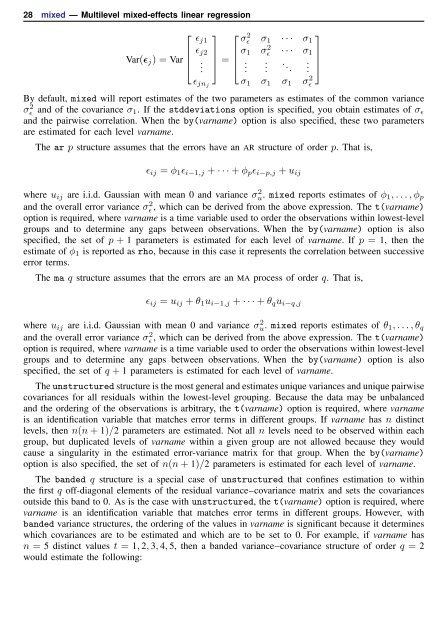mixed - Stata
mixed - Stata
mixed - Stata
Create successful ePaper yourself
Turn your PDF publications into a flip-book with our unique Google optimized e-Paper software.
28 <strong>mixed</strong> — Multilevel <strong>mixed</strong>-effects linear regression<br />
⎡<br />
ɛ<br />
⎤ ⎡<br />
j1 σɛ 2 σ 1 · · · σ<br />
⎤<br />
1<br />
ɛ j2<br />
Var(ɛ j ) = Var ⎢<br />
⎣ . ⎥<br />
⎦ = σ 1 σɛ 2 · · · σ 1<br />
⎢<br />
⎣<br />
.<br />
.<br />
.<br />
. ..<br />
. ⎥ .. ⎦<br />
ɛ jnj σ 1 σ 1 σ 1 σɛ<br />
2<br />
By default, <strong>mixed</strong> will report estimates of the two parameters as estimates of the common variance<br />
σ 2 ɛ and of the covariance σ 1. If the stddeviations option is specified, you obtain estimates of σ ɛ<br />
and the pairwise correlation. When the by(varname) option is also specified, these two parameters<br />
are estimated for each level varname.<br />
The ar p structure assumes that the errors have an AR structure of order p. That is,<br />
ɛ ij = φ 1 ɛ i−1,j + · · · + φ p ɛ i−p,j + u ij<br />
where u ij are i.i.d. Gaussian with mean 0 and variance σu 2. <strong>mixed</strong> reports estimates of φ 1, . . . , φ p<br />
and the overall error variance σɛ 2 , which can be derived from the above expression. The t(varname)<br />
option is required, where varname is a time variable used to order the observations within lowest-level<br />
groups and to determine any gaps between observations. When the by(varname) option is also<br />
specified, the set of p + 1 parameters is estimated for each level of varname. If p = 1, then the<br />
estimate of φ 1 is reported as rho, because in this case it represents the correlation between successive<br />
error terms.<br />
The ma q structure assumes that the errors are an MA process of order q. That is,<br />
ɛ ij = u ij + θ 1 u i−1,j + · · · + θ q u i−q,j<br />
where u ij are i.i.d. Gaussian with mean 0 and variance σu 2. <strong>mixed</strong> reports estimates of θ 1, . . . , θ q<br />
and the overall error variance σɛ 2 , which can be derived from the above expression. The t(varname)<br />
option is required, where varname is a time variable used to order the observations within lowest-level<br />
groups and to determine any gaps between observations. When the by(varname) option is also<br />
specified, the set of q + 1 parameters is estimated for each level of varname.<br />
The unstructured structure is the most general and estimates unique variances and unique pairwise<br />
covariances for all residuals within the lowest-level grouping. Because the data may be unbalanced<br />
and the ordering of the observations is arbitrary, the t(varname) option is required, where varname<br />
is an identification variable that matches error terms in different groups. If varname has n distinct<br />
levels, then n(n + 1)/2 parameters are estimated. Not all n levels need to be observed within each<br />
group, but duplicated levels of varname within a given group are not allowed because they would<br />
cause a singularity in the estimated error-variance matrix for that group. When the by(varname)<br />
option is also specified, the set of n(n + 1)/2 parameters is estimated for each level of varname.<br />
The banded q structure is a special case of unstructured that confines estimation to within<br />
the first q off-diagonal elements of the residual variance–covariance matrix and sets the covariances<br />
outside this band to 0. As is the case with unstructured, the t(varname) option is required, where<br />
varname is an identification variable that matches error terms in different groups. However, with<br />
banded variance structures, the ordering of the values in varname is significant because it determines<br />
which covariances are to be estimated and which are to be set to 0. For example, if varname has<br />
n = 5 distinct values t = 1, 2, 3, 4, 5, then a banded variance–covariance structure of order q = 2<br />
would estimate the following:
















